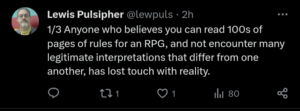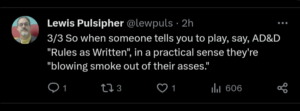The old man is yelling at clouds again.
Fortunately for us, this provides an excellent opportunity to refresh our memories on how a “motte and bailey” con works.
Here is the motte of an obvious and uncontroversial statement:
And here is the bailey of his bold and controversial claim:

You see the leap in logic there?
First of all, for the honest reader, AD&D does not have many legitimate interpretations. Plenty of games run to hundreds of pages and are chock-a-block with unclear passages. Those games are forgotten and unlamented because there’s no there there. AD&D is not one of those games. Gary’s prose may be difficult for the unlettered to follow and his organization somewhat lacking, but his rules are clear and concise. A careful reading allows the player to determine both Gary’s intent – thanks in large part to his heavy ladling of design notes throughout the text – and the proper implementation of his rules at the table. Dishonest brokers can argue over definitions and engage in the usual inversion of words to argue that “shall not” means “shall” until they are blue in the face, but their refusal or inability to accept the existence of plain meaning definitions of words and passages is their problem. It doesn’t handcuff those of us in the reality-based community who accept the existence of precise and meaningful language.
Second of all, the existence of passages that allow for legitimately different interpretations in no way demonstrates the existence of passages that do not. Lew hints without actually stating that the existence of any unclear and unfixed rules necessarily negates the existence of the ruleset as a whole. He cannot say that outright due to the absurdity and obviously fallacious nature of such a claim. Instead, he engages in the worst sort of foggy Reddit-tier thinking in the hopes that we won’t notice what he did.
But we did notice, Lew.
There’s a deeper deception at play here, and it’s one that the #BROSR detractors consistently engage in despite incessant evidence that the lie doesn’t hold any water.
*sigh*
Let me explain it again, and I’ll try to use smaller words so old confused men like Lew can understand.
Using the rules of D&D as written does not mean that every game must look the same. It is not a limitation on either the DM or the player*. It is an agreed upon framework within which huge flights of fancy are not only permitted, but required. There is a wealth of scope within the rules of AD&D for a tremendous variety in campaign styles, and you don’t need to stretch definitions to do so. Once you begin to study the rules in any depth, you find a rich and clear and attainable structure on which to hang your bright tassels and flamboyant hats and magic mirror-shades. It is an extraordinarily complex structure filled with easily forgotten filigrees and pearls of hidden fun, and rare is the session that passes without some stumble. But it is also an extraordinarily robust engine that can handle a few hiccups and keep on revving.
AD&D is an amazing game.
Lew should play it sometime. He might even enjoy it.
*Again, I’ll point out that binary distinction loses all meaning when you play the game properly.


There are only a few passages that remain unclear or contradictory after close reading. I can only think of two places where he contradicts himself. One is when he talks about allowed armor for multiclassed elfs, and the other is when he talks about the encumbrance of magic armor.
Are either of these actually contradictory? I couldn’t tell you. Are there other places? Probably.
But the game as a whole hangs together remarkably well these 44 years later.